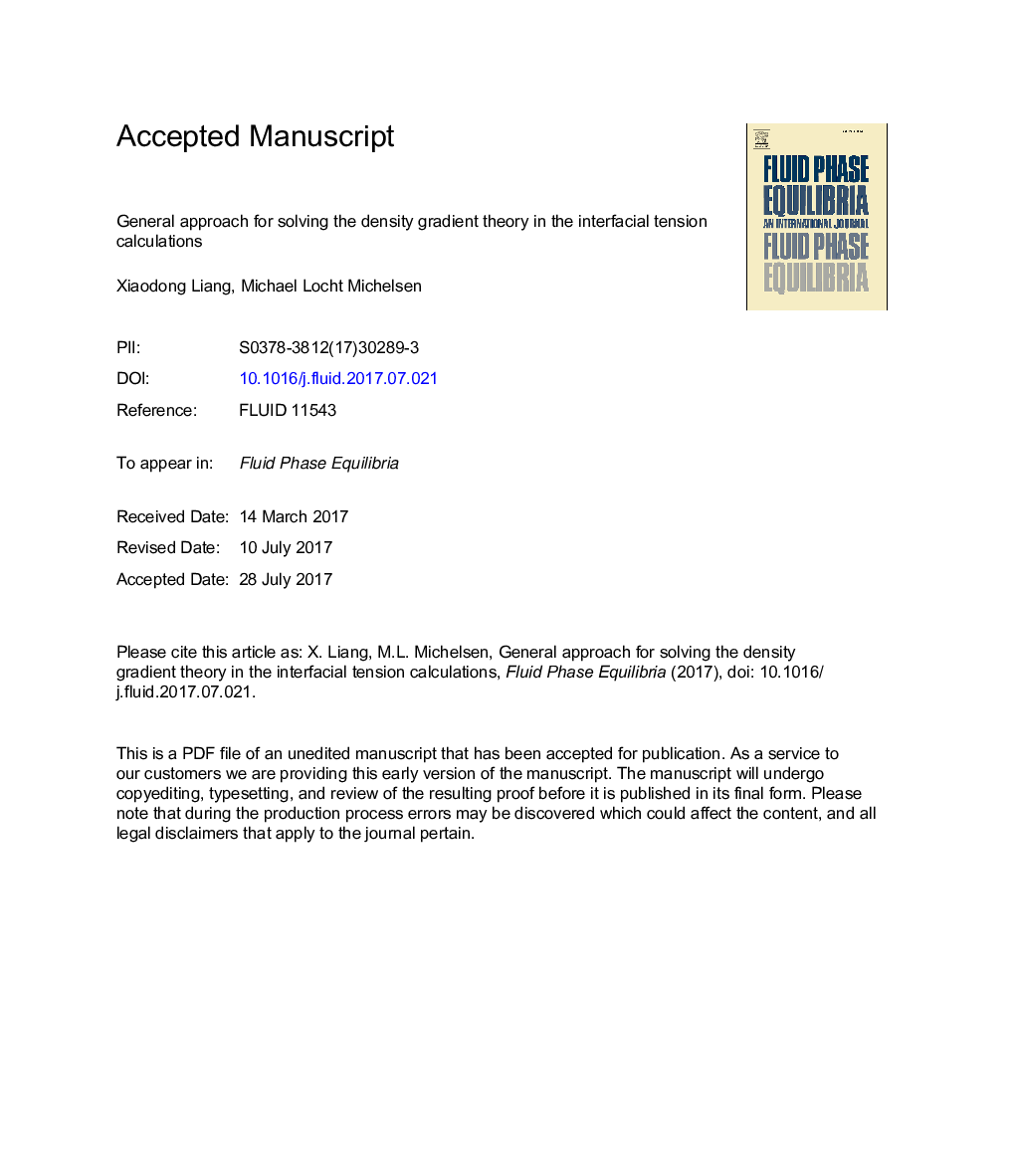| کد مقاله | کد نشریه | سال انتشار | مقاله انگلیسی | نسخه تمام متن |
|---|---|---|---|---|
| 4767900 | 1424506 | 2017 | 39 صفحه PDF | دانلود رایگان |
عنوان انگلیسی مقاله ISI
General approach for solving the density gradient theory in the interfacial tension calculations
ترجمه فارسی عنوان
روش عمومی برای حل تئوری گرادیان چگالی در محاسبات تنش بین فضایی
دانلود مقاله + سفارش ترجمه
دانلود مقاله ISI انگلیسی
رایگان برای ایرانیان
کلمات کلیدی
ترجمه چکیده
در چارچوب نظریه ی گرانش تراکم، کشش بین فسفری را می توان با پیدا کردن پروفیل تراکم که حداقل یک انتگرال دو اصطلاح را بر روی سیستم عرض عرض نامحدود می کند محاسبه می شود. یافته شده است که دو انتگرال یک اختلاف ثابت در طول رابط برای رابط یکنواخت مسطح را نشان می دهد و این تفاوت کوچکتر می شود چون عرض رابط افزایش می یابد. این یافته ها به طور طبیعی منجر به یک روش راه حل می شود که شامل یک حلقه درونی و یک حلقه بیرونی برای محاسبه تنش میان فازی یک رابط مسطح است. حلقه بیرونی با رابطه بین تنش میان فازی و عرض رابط در ارتباط است و ما را قادر می سازد نتایج دقیق از محاسبات عرض محدود را بدست آوریم. حلقه داخلی تنش موازی برای یک عرض رابط داده شده را با تنظیم پروفیل های چگالی، که در آن انتگرال ها با ترکیبی از تقریب چندجمله ای مبتنی بر الگوریتم کوادراتور گاوس-لاباتو و درونیابی لاگرانژ، ارزیابی می شود، کاهش می دهد. یک تقسیم بهتر تنش بین فسفری توسط یکپارچگی مسیر در امتداد پروفیل تراکم استخراج شده است. این استراتژی ها ما را قادر می سازد تا راه حل های دقیق را با معیارهای تحمل کمتر و تعداد کمتر ارزیابی اموال ترمودینامیکی در مقایسه با سایر روش ها به دست آوریم. عملکرد الگوریتم با پارامترهای توصیه شده برای سیستم های مختلف مورد تجزیه و تحلیل قرار گرفته است، و کارایی بیشتر با تئوری گرادیان چگالی میانگین هندسی، که تنها نیاز به حل معادلات جبری غیر خطی دارد، مقایسه شده است. نتایج نشان می دهد که الگوریتم تنها 5-10 برابر کارایی کمتر از حل مساله گرادیان چگالی متوسط است.
موضوعات مرتبط
مهندسی و علوم پایه
مهندسی شیمی
مهندسی شیمی (عمومی)
چکیده انگلیسی
Within the framework of the density gradient theory, the interfacial tension can be calculated by finding the density profiles that minimize an integral of two terms over the system of infinite width. It is found that the two integrands exhibit a constant difference along the interface for a finite planar interface, and this difference becomes smaller as the interface width increases. These findings naturally lead to a solution procedure that consists of an inner loop and an outer loop for calculating the interfacial tension of a planar interface. The outer loop deals with the relationship between the interfacial tension and the interface width, and it permits us to obtain accurate results from finite width calculations. The inner loop minimizes the interfacial tension for a given interface width by adjusting the density profiles, in which the integrals are evaluated by a combination of Gauss-Lobatto quadrature and Lagrange interpolation based polynomial approximation. A better approximation of the interfacial tension is derived by a path integration along the density profiles. These strategies enable us to obtain accurate solutions with looser tolerance criteria and a fewer number of thermodynamic property evaluations compared to other methods. The performance of the algorithm with recommended parameters is analyzed for various systems, and the efficiency is further compared with the geometric-mean density gradient theory, which only needs to solve nonlinear algebraic equations. The results show that the algorithm is only 5-10 times less efficient than solving the geometric-mean density gradient theory.
ناشر
Database: Elsevier - ScienceDirect (ساینس دایرکت)
Journal: Fluid Phase Equilibria - Volume 451, 15 November 2017, Pages 79-90
Journal: Fluid Phase Equilibria - Volume 451, 15 November 2017, Pages 79-90
نویسندگان
Xiaodong Liang, Michael Locht Michelsen,
